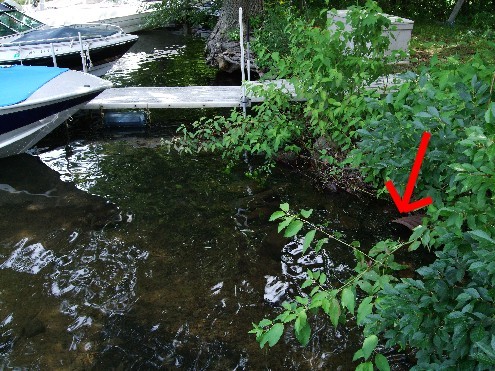
The Wyatt’s cove culvert has shown remarkable improvement in water quality over the last 20 years.
I was sitting on the porch today thinking of things to write about and saw the boat from the Darrin Freshwater Institute pull up and take a water sample from what they call the Wyatt’s cove culvert. So I called the Institute and spoke with Larry Eichler and learned a few things.
1.) The Darrin Freshwater Institute regularly samples locations throughout the lake and monitors conditions. The Wyatt’s cove culvert in the center of the Landing has shown dramatic improvements over the last 20 years. Mr. Eichler attributed this to the town sewer system that was installed in the 1980’s. There is lessened algae growth on the bottom of Wyatt’s cove and fecal coliform levels are in accepted ranges. The Institute checks this site numerous times over the course of the summer but it has reached a point, where Mr. Eichler said; “We don’t really see problems with that site anymore. We monitor but that site has shown remarkable improvement.”
2.) When asked if he could give any conclusions about the Lake George basin as a whole, he responded; “We have seen salt levels rise dramatically over the past few decades”. In 1980 (the first year salt was regularly tested for) salt levels averaged 6 parts per million, by 2008 this level had risen to 16 parts per million, almost tripling. When asked what this could be attributed to, Mr. Eichler explained that while waste water does contain salt which usually goes untreated through the sewage treatment cycle, most salt enters the lake through the application of road salt on surrounding area roads in the winter.
3.) Zebra mussels have not been found to date in the Huletts area. They have been found at 8 locations throughout the lake, 6 in the south and 2 in the north, but the lake’s low levels of calcium make it hard for the mussels to survive. Zebra mussel’s need roughly 20 parts of calcium per million in order for the shells to harden, whereas Lake George averages 12 parts of calcium per million in most locations. Where they have been found, calcium levels have been heightened. In these locations, the problem is being dealt with by hand harvesting by underwater divers which seems to be working. In the areas they have been found, calcium levels have been high. Cement seawall’s have known calcification effects and the Darrin Fresh Water Institute is studying these effects.
